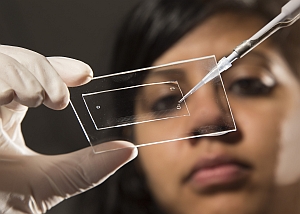
Graduate student Debolina Chatterjee adds fluid sample to the microfluidics test chip. (Mark A. Philbrick, Brigham Young University)
Chemical researchers at Brigham Young University in Utah created a microfluidics device for lab tests that indicates the presence and concentrations of target substances with the naked eye. The findings of the team led by chemistry professor Adam Woolley appear online in the journal Analytical Chemistry (paid subscription required).
Woolley’s team designed the device on a hand-held strip of clear plastic (pictured left). The plastic strip has microscale channels etched into its surface that draws fluid into and along the channel with capillary action, at a rate of about one centimeter per second. The channels can be configured to test for a specific substance by lining the channels with a known receptor — a chemical known to react predictably to that substance — and let others pass by unimpeded.
The channels on the chip are engineered to close and stop the flow of fluid when enough of the receptors react to the target substance. Thus when the receptors react to the target substance by closing the channel and stopping the flow, it indicates the presence of the target molecule in the test fluid.
The flow of the fluid through the channel also acts as an inverse indicator of the substance’s concentration in the sample. The higher the concentration of the substance in the fluid, the faster the receptors will react to the target substance and stop the flow. Thus the shorter the distance that the fluid flows through the channel, the higher the concentration of the target substance in the sample. Likewise, the longer it takes to stop the flow in the channel, the lower the concentration of the target substance.
The chip makes it possible to see first-hand the presence and concentrations of target substances, without any added detectors. Woolley says this feature can make the device suitable for inexpensive diagnostic tests for a variety of diseases and genetic disorders, including at the point of care. “The nice thing about the system that we have developed is that this could be done anywhere,” says Woolley. “Somebody could put the sample in, look at it, and have the result they need.”
In the following video, Woolley and colleagues demonstrate the operation of the chip.
- New Non-Plastic Medical Testing Film Developed
- Blood Test Technology Devised with Lab Chip, Smartphone App
- NIH to Fund Development of Organ-On-Chip Devices
- Latent Tuberculosis Test Devised for Single Chip
- Cancer Stem Cell Drug Screening Chip Developed
* * *

 RSS - Posts
RSS - Posts
[…] Lab-On-A-Chip Device Built for Visual Evaluation […]